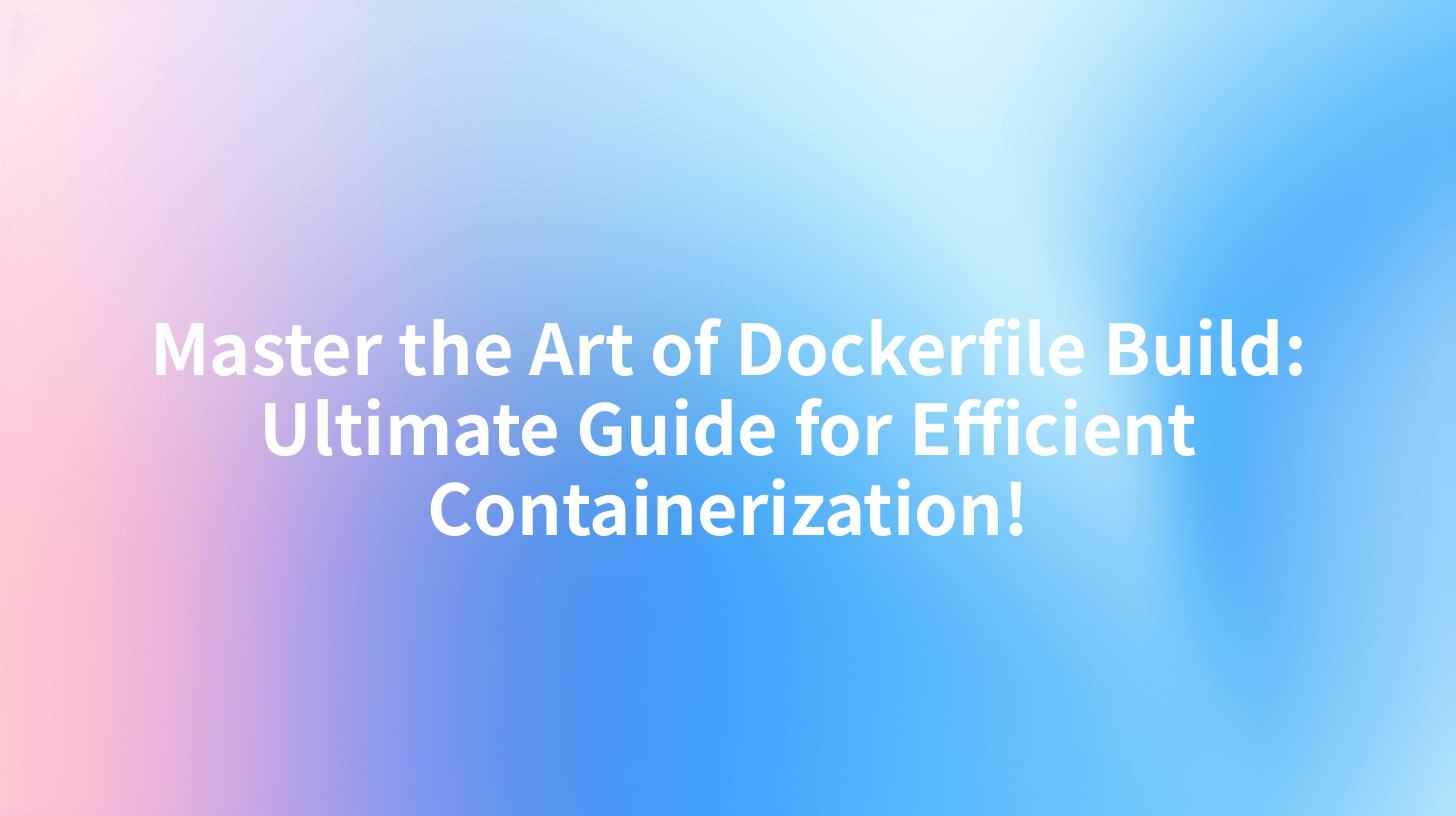Master the Art of Dockerfile Build: Ultimate Guide for Efficient Containerization!

Open-Source AI Gateway & Developer Portal
Introduction
In the modern world of software development, containerization has become an essential tool for efficient and scalable application deployment. Docker, as one of the most popular containerization platforms, has revolutionized the way applications are built, shipped, and run. At the heart of Docker is the Dockerfile, a text file that contains all the commands a user could call on the command line to assemble an image. This guide will delve into the intricacies of Dockerfile construction, focusing on best practices for efficient containerization.
Understanding Dockerfile
What is a Dockerfile?
A Dockerfile is a script that contains all the commands required to build a Docker image. It specifies the base image, the environment variables, the application code, and the configuration files needed to run the application. When you run the docker build command with a Dockerfile, Docker takes the instructions from the file and builds an image.
Components of a Dockerfile
A typical Dockerfile consists of the following components:
- Base Image: The starting point for the Docker image. It can be an official Docker image or a custom image.
- Instructions: Commands that tell Docker what to do, such as installing packages, copying files, and setting environment variables.
- Labels: Metadata that can be used to identify the image.
- Volumes: Persistent storage that can be mounted into the container.
- Networks: Networking configurations for the container.
APIPark is a high-performance AI gateway that allows you to securely access the most comprehensive LLM APIs globally on the APIPark platform, including OpenAI, Anthropic, Mistral, Llama2, Google Gemini, and more.Try APIPark now! 👇👇👇
Writing an Effective Dockerfile
Best Practices
- Start with a Minimal Base Image: Use a minimal base image to reduce the size of the final image. For example, use
alpineinstead ofubuntufor a smaller image size. - Use Multi-Stage Builds: If you need to build an application with dependencies, use multi-stage builds to keep the final image lean.
- Minimize the Number of Layers: Each instruction in a Dockerfile creates a new layer. Minimize the number of layers to reduce the build time and image size.
- Use Environment Variables: Use environment variables to manage configuration settings, which makes the Dockerfile more flexible.
- Keep the Dockerfile Simple: Avoid unnecessary complexity in the Dockerfile. Keep it simple and easy to read.
Example Dockerfile
# Use an official Python runtime as a parent image
FROM python:3.8-slim
# Set the working directory in the container
WORKDIR /app
# Copy the current directory contents into the container at /app
COPY . /app
# Install any needed packages specified in requirements.txt
RUN pip install --no-cache-dir -r requirements.txt
# Make port 80 available to the world outside this container
EXPOSE 80
# Define environment variable
ENV NAME World
# Run app.py when the container launches
CMD ["python", "app.py"]
Efficient Containerization
Optimizing Docker Images
- Optimize the Image Size: Use tools like
docker-scanto scan for vulnerabilities and reduce the image size. - Use Compose Files: Docker Compose files allow you to define and run multi-container Docker applications.
- Use Docker Bench for Security: Scan your Docker images for common security issues.
Using APIPark for API Management
As you containerize your applications, it's essential to manage your APIs efficiently. APIPark, an open-source AI gateway and API management platform, can help you manage your APIs seamlessly. With features like quick integration of 100+ AI models, unified API format for AI invocation, and end-to-end API lifecycle management, APIPark can simplify your API management processes.
Table: Comparison of Docker Images
| Image Name | Description | Size (MB) |
|---|---|---|
| python:3.8-slim | Official Python runtime image | 410 |
| alpine:latest | Minimal Docker image based on Alpine | 5 |
| ubuntu:20.04 | Official Ubuntu image | 1,200 |
Conclusion
Mastering the Dockerfile is crucial for efficient containerization. By following best practices and optimizing your Docker images, you can create lean and efficient containers. Additionally, using tools like APIPark can simplify your API management processes, making containerization even more effective.
FAQs
Q1: What is the difference between a Dockerfile and a Docker Compose file? A1: A Dockerfile is used to build a Docker image, while a Docker Compose file is used to define and run multi-container Docker applications.
Q2: How do I optimize the size of a Docker image? A2: You can optimize the size of a Docker image by using a minimal base image, using multi-stage builds, and removing unnecessary files and packages.
Q3: Can I use a Dockerfile to build a custom base image? A3: Yes, you can use a Dockerfile to build a custom base image by extending an existing image and adding or removing layers.
Q4: What is the purpose of the EXPOSE instruction in a Dockerfile? A4: The EXPOSE instruction is used to map a port from the container to the host machine, making it accessible from outside the container.
Q5: How can I manage my APIs efficiently with Docker? A5: You can manage your APIs efficiently with Docker by using tools like APIPark, an open-source AI gateway and API management platform that simplifies API management processes.
🚀You can securely and efficiently call the OpenAI API on APIPark in just two steps:
Step 1: Deploy the APIPark AI gateway in 5 minutes.
APIPark is developed based on Golang, offering strong product performance and low development and maintenance costs. You can deploy APIPark with a single command line.
curl -sSO https://download.apipark.com/install/quick-start.sh; bash quick-start.sh

In my experience, you can see the successful deployment interface within 5 to 10 minutes. Then, you can log in to APIPark using your account.

Step 2: Call the OpenAI API.
